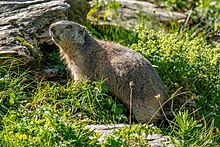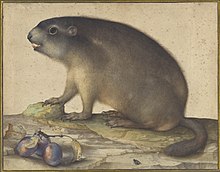
Squirrels are members of the family Sciuridae, a family that includes small or medium-sized rodents. The squirrel family includes tree squirrels, ground squirrels, and flying squirrels. Squirrels are indigenous to the Americas, Eurasia, and Africa, and were introduced by humans to Australia. The earliest known fossilized squirrels date from the Eocene epoch, and among other living rodent families, the squirrels are most closely related to the mountain beaver and to the dormice.

The groundhog, also known as the woodchuck, is a rodent of the family Sciuridae, belonging to the group of large ground squirrels known as marmots. The groundhog is a lowland creature of North America; it is found through much of the Eastern United States, across Canada and into Alaska. It was first scientifically described by Carl Linnaeus in 1758.

Ground squirrels are rodents of the squirrel family (Sciuridae) that generally live on the ground or in burrows, rather than in trees like the tree squirrels. The term is most often used for the medium-sized ground squirrels, as the larger ones are more commonly known as marmots or prairie dogs, while the smaller and less bushy-tailed ground squirrels tend to be known as chipmunks.
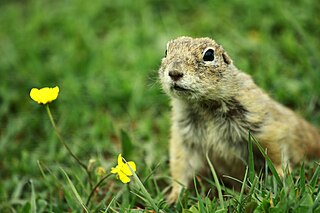
Spermophilus is a genus of ground squirrels in the squirrel family. As traditionally defined the genus was very species-rich, ranging through Europe, Asia and North America, but this arrangement was found to be paraphyletic to the certainly distinct prairie dogs, marmots, and antelope squirrels. As a consequence, all the former Spermophilus species of North America have been moved to other genera, leaving the European and Asian species as true Spermophilus.

The hoary marmot is a species of marmot that inhabits the mountains of northwest North America. Hoary marmots live near the tree line on slopes with grasses and forbs to eat and rocky areas for cover.

The Vancouver Island marmot naturally occurs only in the high mountains of Vancouver Island, in British Columbia. This particular marmot species is large compared to some other marmots, and most other rodents. Marmots are the largest members of the Sciuridae family, with weights of adults varying from 3 to 7 kg depending on age and time of year.

The alpine marmot is a large ground-dwelling squirrel, from the genus of marmots. It is found in high numbers in mountainous areas of central and southern Europe, at heights between 800 and 3,200 m (2,600–10,500 ft) in the Alps, Carpathians, Tatras and Northern Apennines. In 1948 they were reintroduced with success in the Pyrenees, where the alpine marmot had disappeared at end of the Pleistocene epoch.

The Olympic marmot is a rodent in the squirrel family, Sciuridae; it occurs only in the U.S. state of Washington, on the middle elevations of the Olympic Peninsula. The closest relatives of this species are the hoary marmot and the Vancouver Island marmot. In 2009, it was declared the official endemic mammal of Washington.

The European ground squirrel, also known as the European souslik, is a species from the squirrel family, Sciuridae. It is among the few European species in the genus Spermophilus. Like all squirrels, it is a member of the rodent order. It is to be found in eastern and central Europe from southern Ukraine, to Asia Minor, Austria, the Czech Republic, Slovakia, Serbia, Greece, Romania, Bulgaria, North Macedonia and north as far as Poland but the range is divided in two parts by the Carpathian Mountains.

The Himalayan marmot is a marmot species that inhabits alpine grasslands throughout the Himalayas and on the Tibetan Plateau. It is IUCN Red Listed as Least Concern because of its wide range and possibly large population.

The bobak marmot, also known as the steppe marmot, is a species of marmot that inhabits the steppes of Eastern Europe and Central Asia. It is a social animal and inhabits steppe grassland, including cultivated field borders. It hibernates for more than half the year. Litter sizes average about five offspring and it takes three years for the young marmots to reach sexual maturity. Male offspring leave the home colony after their second winter, and about 60% of mature females give birth in any one year.

The mountain ground squirrel is a rodent that is native to southwestern Angola, western Namibia, and western South Africa. It is also known as the Kaoko ground squirrel or the Damara ground squirrel.

The long-tailed marmot or golden marmot is a marmot species in the family Sciuridae. It occurs in mountainous regions in the central parts of Asia where it lives in open or lightly wooded habitats, often among rocks where dwarf junipers grow. It is IUCN Red Listed as Least Concern. As suggested by its name, it is a relatively long-tailed species of marmot.

The gray marmot, grey marmot, or Altai marmot is a species of rodent in the squirrel family Sciuridae. It is one of the larger marmots in the genus Marmota. It occurs in mountainous grasslands and shrub lands of central Asia, and is one of the 9 Palearctic (Eurasia) species. It is found in Xinjiang Province in China, southeastern Kazakhstan, Kyrgyzstan, Mongolia, and in the Altai and Tien Shan Mountains in southeastern Siberia in Russia. In the Mongolian Altai, its range overlaps with that of the Tarbagan marmot. Gray marmots form social groups, live in burrows, and hibernate.

The Alaska marmot, also known as the Brooks Range marmot or the Brower's marmot, is a species of rodent in the family Sciuridae. Once considered to be the same species as the hoary marmot, it is now known to be unique. Alaska marmots are found in the scree slopes of the Brooks Range, Alaska. Specifically, they prefer to dwell on rocky, mountainous terrain, generally near lakes. They eat vegetation found on mountainsides, such as grasses, seeds, and lichen. Their relatively thick bodies are covered in dense, grey fur. They live in large colonies that consist of multiple families. During the winter, they hibernate for long periods of time in burrows. While not well researched, they are not believed to be particularly threatened, by human activity or otherwise. The Alaskan government has designated February 2 as "Marmot Day," a holiday intended to recognize the prevalence of marmots in the state, similar to the more widely celebrated American holiday of Groundhog Day.
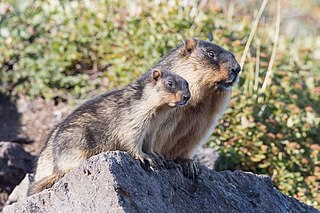
The black-capped marmot is a species of rodent in the family Sciuridae. It is endemic to the Russian Far East, but its range is discontinuous and divided into three main parts, each with its own subspecies. The black-capped marmot lives in arctic tundra and alpine habitats from near sea-level to an altitude of 2,000 m (6,600 ft). Depending on exact subpopulation, they hibernate for 6–8 months each year, which is long for a marmot.

The Menzbier's marmot is a species of rodent in the family Sciuridae from Central Asia. Its name commemorates Russian zoologist Mikhail Aleksandrovich Menzbier.

The tarbagan marmot is a species of rodent in the family Sciuridae. It is found in China, northern and western Mongolia, and Russia. In the Mongolian Altai Mountains, its range overlaps with that of the Gray marmot. The species was classified as endangered by the IUCN in 2008.
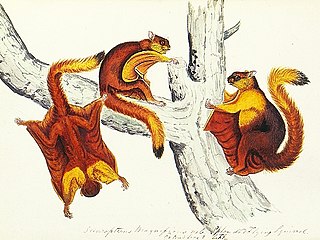
Hodgson's giant flying squirrel is a species of rodent in the family Sciuridae. This large flying squirrel lives in Himalayan forests in Asia. Like other flying squirrels, it is nocturnal and able to glide long distances between trees by spreading out its patagium, skin between its limbs.

The forest-steppe marmot is a rodent species of the marmot genus found in south-central Russia. It lives in wooded forest steppe at an altitude of 180–450 m (590–1,480 ft) in a relatively small region located directly east of the upper Ob River. It has traditionally been considered a subspecies of the similar, more southerly distributed gray marmot, but was separated mainly due to different diploid numbers.
